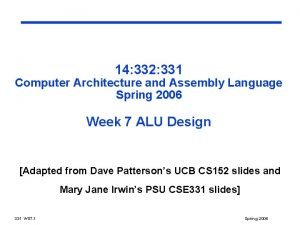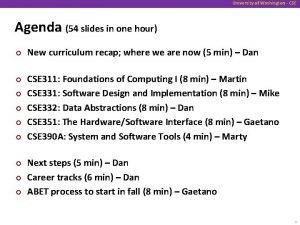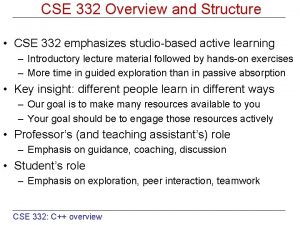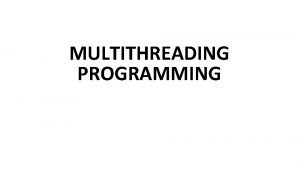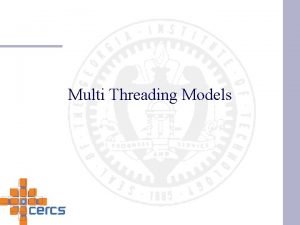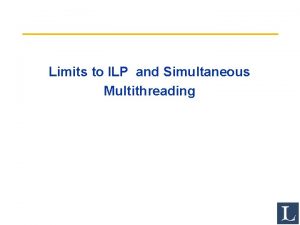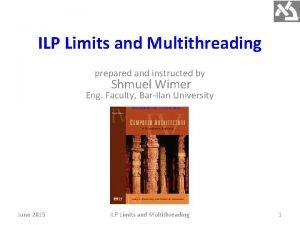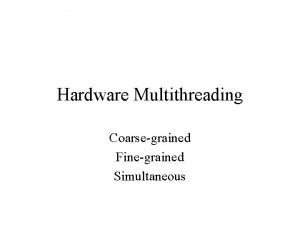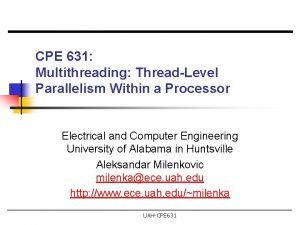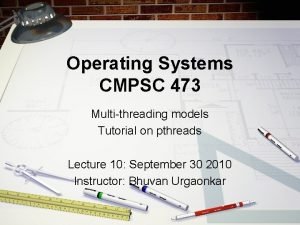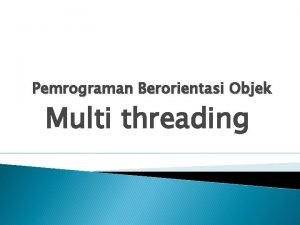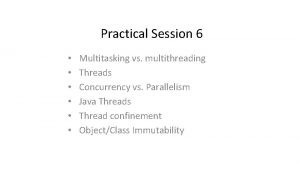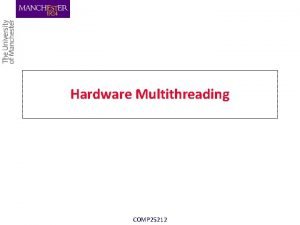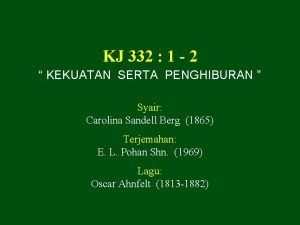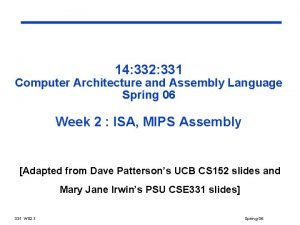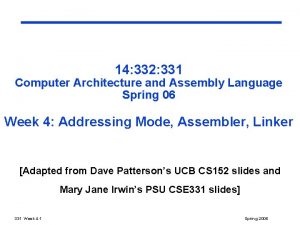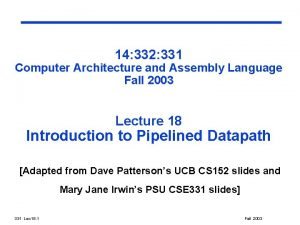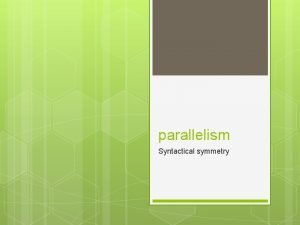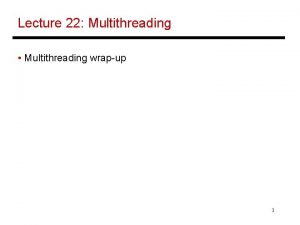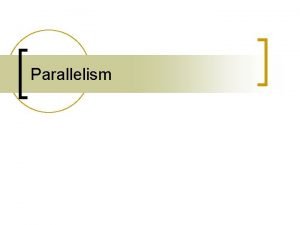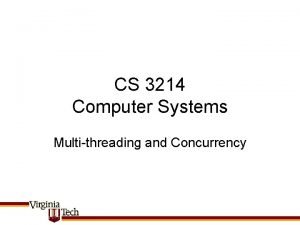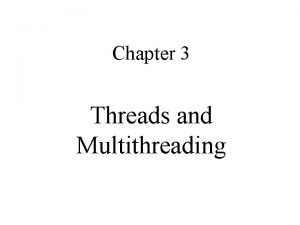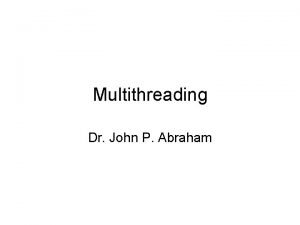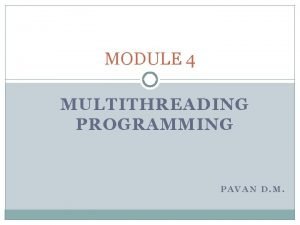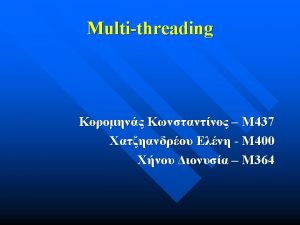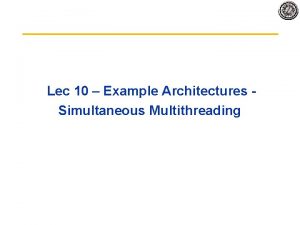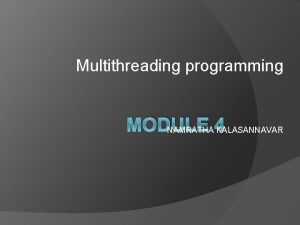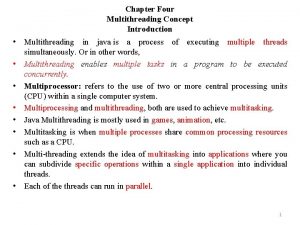CSE 332 Intro to Parallelism Multithreading and ForkJoin





















![Part 2: sum routine int sum(int[] arr){// can be a static method int len Part 2: sum routine int sum(int[] arr){// can be a static method int len](https://slidetodoc.com/presentation_image_h2/42154c82dbabdf37d275c5a881e5e474/image-22.jpg)
![Parameterizing by number of threads int sum(int[] arr, int num. Ts){ int ans = Parameterizing by number of threads int sum(int[] arr, int num. Ts){ int ans =](https://slidetodoc.com/presentation_image_h2/42154c82dbabdf37d275c5a881e5e474/image-23.jpg)









- Slides: 32

CSE 332: Intro to Parallelism: Multithreading and Fork-Join Richard Anderson Spring 2016 1

Announcements • Read parallel computing notes by Dan Grossman 2. 1 -3. 4 • Homework 5 – available Wednesday • Exams – not graded yet 2

Sequential • Sum up N numbers in an array – Complexity? 3

Parallel Sum • Sum up N numbers in an array – with two processors 4

Parallel Sum • Sum up N numbers in an array – with N processors? 5

Parallel Sum • Sum up N numbers in an array + + + + + + + + • Complexity? • How many processors? • Faster with infinite processors? 6

Changing a Major Assumption • So far, we have assumed: One thing happens at a time • Called sequential programming • Dominated until roughly 2005 – what changed? 7

A Simplified History From roughly 1980 -2005, desktop computers got exponentially faster at running sequential programs – About twice as fast every couple years Writing parallel (multi-threaded) code is harder than sequential – Especially in common languages like Java and C But nobody knows how to continue this – Increasing clock rate generates too much heat – Relative cost of memory access is too high – But we can keep making “wires exponentially smaller” (Moore’s “Law”), so put multiple processors on the same chip (“multicore”) 8

Who Implements Parallelism • User • Application • Operating System • Programming Language, Compiler • Algorithm • Processor Hardware 9

Parallelism vs. Concurrency Parallelism: Use extra resources to solve a problem faster Concurrency: Manage access to shared resources work requests resource 10

An analogy A program is like a recipe for a cook – Sequential: one cook who does one thing at a time Parallelism: (Let’s get the job done faster!) – Have lots of potatoes to slice? – Hire helpers, hand out potatoes and knives – But too many chefs and you spend all your time coordinating Concurrency: (We need to manage a shared resource) – Lots of cooks making different things, but only 4 stove burners – Want to allow access to all 4 burners, but not cause spills or incorrect burner settings 11

Shared Memory with Threads Old story: A running program has – One program counter (current statement executing) – One call stack (with each stack frame holding local variables) – Objects in the heap created by memory allocation (i. e. , new) • (nothing to do with data structure called a heap) – Static fields New story: – A set of threads, each with its own program counter & call stack • No access to another thread’s local variables – Threads can share static fields / objects • To communicate, write values to some shared location that another threads from 12

Old Story: one call stack, one pc • Call stack with local variables • pc determines current statement • local variables are numbers/null or heap references Heap for all objects and static fields pc=0 x… … … 13 13

New Story: Shared Memory with Threads, each with own unshared call stack and “program counter” Heap for all objects and static fields, shared by all threads pc=0 x… … … 14

Other models We will focus on shared memory, but you should know several other models exist and have their own advantages (see notes) • Message-passing: Each thread has its own collection of objects. Communication is via explicitly sending/receiving messages – Cooks working in separate kitchens, mail around ingredients • Dataflow: Programmers write programs in terms of a DAG. A node executes after all of its predecessors in the graph – Cooks wait to be handed results of previous steps • Data parallelism: Have primitives for things like “apply function to every element of an array in parallel” 15

Our Needs To write a shared-memory parallel program, need new primitives from a programming language or library • Ways to create and run multiple things at once – Let’s call these things threads • Ways for threads to share memory – Often just have threads with references to the same objects • Ways for threads to coordinate (a. k. a. synchronize) – For now, a way for one thread to wait for another to finish – Other primitives when we study concurrency 16

Threads vs. Processors What happens if you start 5 threads on a machine with only 4 processors? 17

Threads vs. Processors For sum operation: – with 3 processors available, using 4 threads would take 50% more time than 3 threads 18

Fork-Join Parallelism 1. Define thread – Java: define subclass of java. lang. Thread, override run 2. Fork: instantiate a thread and start executing – Java: create thread object, call start() 3. Join: wait for thread to terminate – Java: call join() method, which returns when thread finishes Above uses basic thread library build into Java Later we’ll introduce a better Fork. Join Java library designed for parallel programming 19

Sum with Threads For starters: have 4 threads simultaneously sum ¼ of the array ans 0 ans 1 ans 2 ans 3 + ans – – Create 4 thread objects, each given ¼ of the array Call start() on each thread object to run it in parallel Wait for threads to finish using join() Add together their 4 answers for the final result 20

Part 1: define thread class Sum. Thread extends java. lang. Thread { int lo; // fields, passed to constructor int hi; // so threads know what to do. int[] arr; int ans = 0; // result Sum. Thread(int[] a, int l, int h) { lo=l; hi=h; arr=a; } } public void run() { //override must have this type for(int i=lo; i < hi; i++) ans += arr[i]; } Because we must override a no-arguments/no-result run, we use fields to communicate across threads 21
![Part 2 sum routine int sumint arr can be a static method int len Part 2: sum routine int sum(int[] arr){// can be a static method int len](https://slidetodoc.com/presentation_image_h2/42154c82dbabdf37d275c5a881e5e474/image-22.jpg)
Part 2: sum routine int sum(int[] arr){// can be a static method int len = arr. length; int ans = 0; Sum. Thread[] ts = new Sum. Thread[4]; for(int i=0; i < 4; i++){// do parallel computations ts[i] = new Sum. Thread(arr, i*len/4, (i+1)*len/4); ts[i]. start(); } for(int i=0; i < 4; i++) { // combine results ts[i]. join(); // wait for helper to finish! ans += ts[i]. ans; } return ans; } 22
![Parameterizing by number of threads int sumint arr int num Ts int ans Parameterizing by number of threads int sum(int[] arr, int num. Ts){ int ans =](https://slidetodoc.com/presentation_image_h2/42154c82dbabdf37d275c5a881e5e474/image-23.jpg)
Parameterizing by number of threads int sum(int[] arr, int num. Ts){ int ans = 0; Sum. Thread[] ts = new Sum. Thread[num. Ts]; for(int i=0; i < num. Ts; i++){ ts[i] = new Sum. Thread(arr, (i*arr. length)/num. Ts, ((i+1)*arr. length)/num. Ts); ts[i]. start(); } for(int i=0; i < num. Ts; i++) { ts[i]. join(); ans += ts[i]. ans; } return ans; } 23

Recall: Parallel Sum • Sum up N numbers in an array + + + + + + + + • Let’s implement this with threads. . . 24

Code looks something like this (using Java Threads) class Sum. Thread extends java. lang. Thread { int lo; int hi; int[] arr; // fields to know what to do int ans = 0; // result Sum. Thread(int[] int l, int h) { … } in parallel The key is to doa, the result-combining public void run(){ // override as well if(hi – lo < SEQUENTIAL_CUTOFF) for(int i=lo; i < hi; i++) – And recursive divide-and-conquer makes ansusing += arr[i]; else { natural this Sum. Thread left = new Sum. Thread(arr, lo, (hi+lo)/2); right= new Sum. Thread(arr, (hi+lo)/2, hi); –Sum. Thread Easier to write and more efficient asymptotically! left. start(); right. start(); left. join(); // don’t move this up a line – why? right. join(); ans = left. ans + right. ans; } } } int sum(int[] arr){ // just make one thread! Sum. Thread t = new Sum. Thread(arr, 0, arr. length); t. run(); return t. ans; 25 }

Recursive problem decomposition Thread: sum range [0, 10) Thread: sum range [0, 5) Thread: sum range [0, 2) Thread: sum range [0, 1) (return arr[0]) Thread: sum range [1, 2) (return arr[1]) add results from two helper threads Thread: sum range [2, 5) Thread: sum range [2, 3) (return arr[2]) Thread: sum range [3, 5) Thread: sum range [3, 4) (return arr[3]) Thread: sum range [4, 5) (return arr[4]) add results from two helper threads Thread: sum range [5, 10) Thread: sum range [5, 7) Thread: sum range [5, 6) (return arr[5]) Thread: sum range [6, 7) (return arr[6]) add results from two helper threads Thread: sum range [7, 10) Thread: sum range [7, 8) (return arr[7]) Thread: sum range [8, 10) Thread: sum range [8, 9) (return arr[8]) Thread: sum range [9, 10) (return arr[9]) add results from two helper threads 26

Divide-and-conquer Same approach useful for many problems beyond sum – If you have enough processors, total time O(log n) – Next lecture: study reality of P << n processors • Will write all our parallel algorithms in this style – But using a special fork-join library engineered for this style • Takes care of scheduling the computation well – Often relies on operations being associative (like +) + + + + 27

Thread Overhead Creating and managing threads incurs cost Two optimizations: 1. Use a sequential cutoff, typically around 500 -1000 • Eliminates lots of tiny threads 2. Do not create two recursive threads; create one thread and do the other piece of work “yourself” • Cuts the number of threads created by another 2 x 28

Half the threads! order of last 4 lines Is critical – why? // wasteful: don’t Sum. Thread left = … Sum. Thread right = … // better: do!! Sum. Thread left = … Sum. Thread right = … left. start(); right. start(); left. start(); right. run(); left. join(); right. join(); ans=left. ans+right. ans; left. join(); // no right. join needed ans=left. ans+right. ans; Note: run is a normal function call! execution won’t continue until we are done with run 29

Better Java Thread Library • Even with all this care, Java’s threads are too “heavyweight” – Constant factors, especially space overhead – Creating 20, 000 Java threads just a bad idea • The Fork. Join Framework is designed to meet the needs of divideand-conquer fork-join parallelism – In the Java 7 standard libraries • (Also available for Java 6 as a downloaded. jar file) – Section will focus on pragmatics/logistics – Similar libraries available for other languages • C/C++: Cilk (inventors), Intel’s Thread Building Blocks • C#: Task Parallel Library • … 30

Different terms, same basic idea To use the Fork. Join Framework: • A little standard set-up code (e. g. , create a Fork. Join. Pool) Don’t subclass Thread Don’t override run Do not use an ans field Don’t call start Don’t just call join Don’t call run to hand-optimize Don’t have a topmost call to run Do subclass Recursive. Task<V> Do override compute Do return a V from compute Do call fork Do call join (which returns answer) Do call compute to hand-optimize Do create a pool and call invoke See the web page for (linked in to project 3 description): “A Beginner’s Introduction to the Fork. Join Framework” 31

Fork Join Framework Version: (missing imports) class Sum. Array extends Recursive. Task<Integer> { int lo; int hi; int[] arr; // fields to know what to do Sum. Array(int[] a, int l, int h) { … } protected Integer compute(){// return answer if(hi – lo < SEQUENTIAL_CUTOFF) { int ans = 0; // local var, not a field for(int i=lo; i < hi; i++) ans += arr[i]; return ans; } else { Sum. Array left = new Sum. Array(arr, lo, (hi+lo)/2); Sum. Array right= new Sum. Array(arr, (hi+lo)/2, hi); left. fork(); // fork a thread and calls compute int right. Ans = right. compute(); //call compute directly int left. Ans = left. join(); // get result from left return left. Ans + right. Ans; } } } static final Fork. Join. Pool fj. Pool = new Fork. Join. Pool(); int sum(int[] arr){ return fj. Pool. invoke(new Sum. Array(arr, 0, arr. length)); // invoke returns the value compute returns } 32
 Simultaneous multithreading: maximizing on-chip parallelism
Simultaneous multithreading: maximizing on-chip parallelism 14:332:331
14:332:331 Uw cse 311
Uw cse 311 Cse 332
Cse 332 Cse332
Cse332 Thread level parallelism in computer architecture
Thread level parallelism in computer architecture Thread dalam java
Thread dalam java What is thread based preemptive multitasking
What is thread based preemptive multitasking Multithreading models
Multithreading models Fine grained multithreading
Fine grained multithreading Fine grained multithreading
Fine grained multithreading Coarse grained multithreading
Coarse grained multithreading Fine grained multithreading
Fine grained multithreading Fine grained multithreading
Fine grained multithreading Multithreading models in os
Multithreading models in os Multithreading patterns
Multithreading patterns Multithreading adalah
Multithreading adalah Ue4 taskgraph
Ue4 taskgraph Multitasking vs multithreading in java
Multitasking vs multithreading in java What is hardware multithreading
What is hardware multithreading L332-15 code urbanisme
L332-15 code urbanisme Kj332
Kj332 14:332:376
14:332:376 14:332:331
14:332:331 14:332:331
14:332:331 Cricothyroidotomy
Cricothyroidotomy Digital vs analog sound
Digital vs analog sound Mechanical ventilation indications
Mechanical ventilation indications 14:332:331
14:332:331 Separately excited dc motor equations
Separately excited dc motor equations 14:332:331
14:332:331 Difference between parallelism and anaphora
Difference between parallelism and anaphora What is a outline
What is a outline

